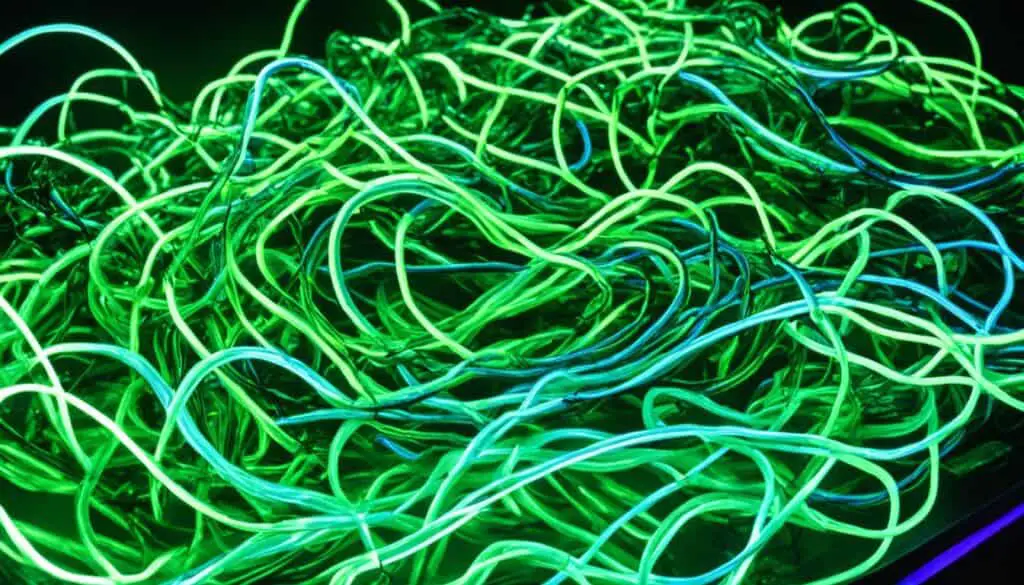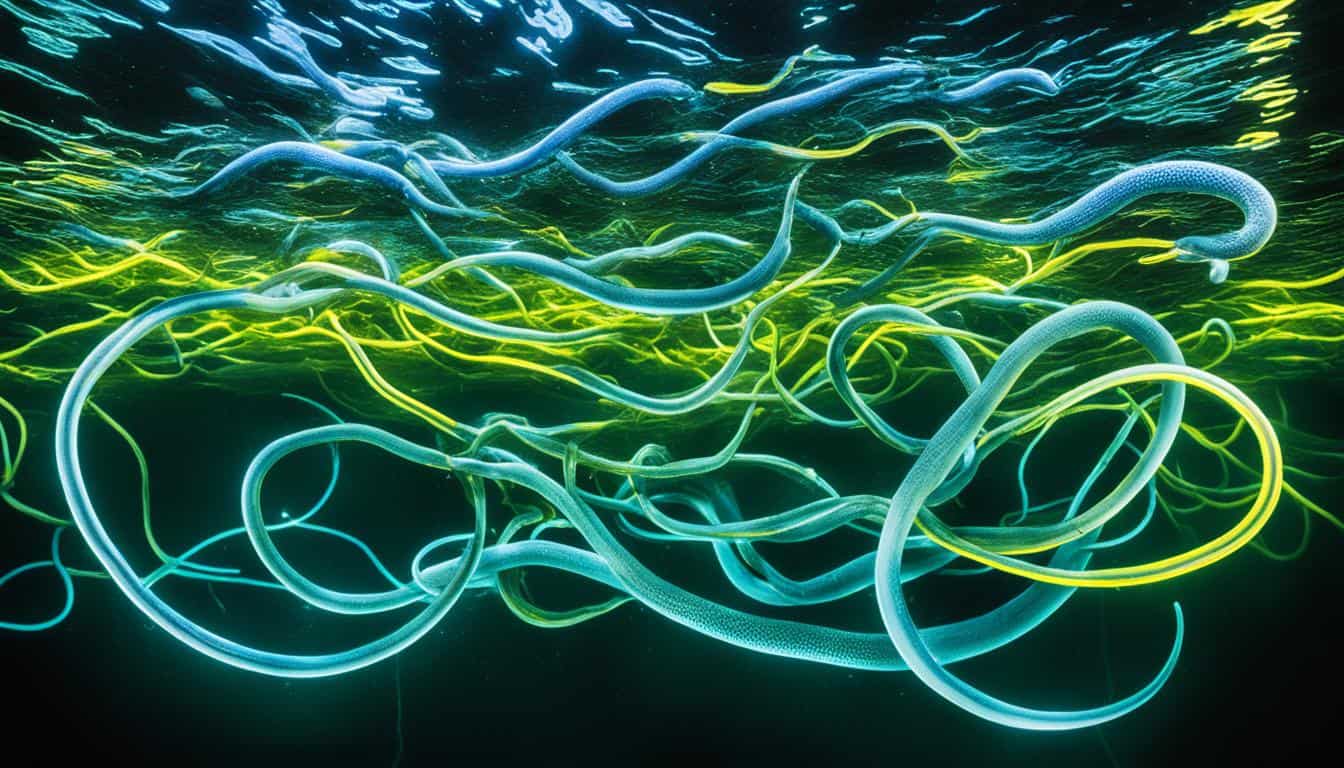In the murky waters of northern South America, you might ask, how do electric eels communicate with their electricity? These fascinating creatures can create strong electrical discharges. These discharges help them hunt and defend themselves. But they also play a key role in how they talk to each other.
Learning about this special way of communicating helps us see how electric eels live together in their underwater world. It shows us their social behaviors and how they survive in their environment.
Understanding Electric Eels and Their Habitat
Electric eels, known as Electrophorus electricus, live in the complex ecosystems of northern South America. They call the Amazon and Orinoco River basins home, stretching across Brazil, Colombia, and Venezuela. Knowing where they live helps us understand their behavior, how they survive, and their special traits.
Native Range and Environment
Electric eels live in slow-moving freshwater that changes a lot with the seasons. When it rains, the water level goes up, giving young eels more space to grow and survive. But when it’s dry, the water level drops, leaving eels in small pools. This makes them more likely to be eaten by predators.
Adaptations to Oxygen-Poor Waters
Electric eels have special traits that let them live in water with little oxygen. They need to come up to the surface to breathe air. This lets them live in places that other fish can’t. They play a unique role in their ecosystem because of this.
| Feature | Description |
|---|---|
| Native Range | Amazon and Orinoco River basins in South America |
| Habitat Characteristics | Slow-moving freshwater, seasonal variability |
| Survival Strategy | Obligate air-breathers adapting to low oxygen levels |
| Seasonal Impact | Juvenile eels thrive in expanded habitats during the rainy season |
| Vulnerability | Isolation in pools during dry spells increases predator threat |
Electricity Generation in Electric Eels
Electric eels have a unique way of making electricity. Their electric organs are key to this process. These organs help them survive in the water by making electricity.
Anatomy of Electric Organs
Electric eels have special organs like the Sach’s organ, Hunter’s organ, and Main organ. Each organ plays a role in making electricity. They have thousands of electrocytes, which are special muscle cells.
These cells are stacked in columns. This setup lets electric eels make strong electric currents.
Role of Electrocytes
Electrocytes are vital for electric organs. When they work together, they create a strong electric charge. Each cell makes a small voltage, adding up to a powerful electric burst.
Electric eels can make electricity up to 500 volts and 1 ampere. This ability helps them stun prey and talk to other fish.
| Electric Organ | Function | Location |
|---|---|---|
| Sach’s Organ | Primary electricity generation | Located in the head region |
| Hunter’s Organ | Supports electricity generation | Behind the Sach’s organ |
| Main Organ | Massive electric discharges | Along most of the body |
How do electric eels use their electricity for communication?
Electric eels have a unique way of using electrical signals for social interaction and awareness. These signals are key in their communication, helping them talk to other eels and understand their world.
They send out weak electric signals for many reasons. Living in murky waters means they can’t see well. So, these signals help them feel their way around by sensing objects and other creatures. This special way of communicating lets them move and live in places where sight is limited.
Electric eels also change the strength and frequency of their signals to send different messages. These changes can show who owns a territory, help identify an individual eel, or signal they’re ready to mate. This shows how complex their social life is.
Their ability to talk through electrical signals shows how smart and social they are. This way of communicating is a key part of what makes electric eels stand out in the animal world.
Communication Methods of Electric Eels
Electric eels have unique ways to communicate that are key to their survival. They use weak electric signals from special organs. These signals help them move and talk to each other in the water.
Weak Electric Discharges
Electric eels send out weak electric signals, about 10 volts, from their Sach’s organ. These signals are a way to talk to other eels and find objects around them. The signals are safe, not strong enough to hurt other living things.
Active Electrolocation
Active electrolocation is a big help for electric eels. They send out weak electric signals to make an electric field around them. This field changes when there are objects or other electric animals nearby.
These changes tell the eel about its surroundings. It can learn about dangers or food this way.
These special ways of communicating show how electric eels have adapted to live in tough places. They use weak electric signals and active electrolocation to move and survive in murky waters. This helps them to live and succeed as a species.
The Impact of Electric Communication on Fish Behavior
Electric communication plays a big role in how fish interact with each other. Electric eels and other electric fish send out responses from other fish. This affects their behavior and helps them survive. It’s key to understanding life under the water.
Responses from Other Fish
When fish near electric eels feel their weak electric fields, they change how they act. They might:
- Avoid potential dangers.
- Become more alert.
- Stay away from electric eels.
This shows how electric signals make fish react quickly to danger. It shows how important electric signals are in their world.
Variations in Electric Discharge Patterns
Electric eels change how they send out electric signals based on the situation. For example:
- They use low-frequency signals to talk to other eels.
- High-frequency bursts to catch prey.
This change in signals tells other fish what the eels are up to. It helps fish adapt and survive in the water. Knowing about these signals helps us understand electric fish and their place in nature.
| Type of Discharge | Context | Impact on Neighboring Fish |
|---|---|---|
| Low-Frequency | Communication with other eels | Increased attention from conspecifics |
| High-Frequency | Prey targeting | Trigger evasive reactions in prey |
Research and Insights into Electrocommunication
Electric eels have amazing ways of communicating through electrocommunication. Scientists have been studying them to learn more about how they live and interact. By understanding their electric organ discharge (EOD), we get insights into their roles in nature.
Recent Scientific Studies
Researchers have looked into the electric organ discharges of electric eels. They found different types of discharges that serve various purposes. Low-voltage discharges help with social interactions, while high-voltage ones are for hunting and defense.
This research shows how electric eels adapt in different situations. It’s a big deal for the study of electrocommunication.
Implications of EOD in Ecology and Behavior
The study of electric eels’ electrocommunication tells us a lot about their role in nature. It shows how they affect predator-prey relationships and social groups in the water. Electric eels are key players in their ecosystems, shaping the behavior of other creatures.
This knowledge helps us understand the complex web of life in aquatic environments.

| Type of EOD | Purpose | Impact on Behavior |
|---|---|---|
| Low-Voltage Discharge | Communication | Facilitates social interaction and navigation |
| High-Voltage Discharge | Hunting and Defense | Intimidates predators and incapacitates prey |
The Role of Electric Eels in Marine Biology
Electric eels are key players in their underwater worlds. They use electrical signals to shape their actions and impact others. This ability to send out electrical discharges changes how different species interact, keeping the ecosystem balanced.
As top predators, electric eels keep the numbers of smaller fish and invertebrates in check. This helps maintain a diverse and healthy marine life. By doing so, they support a wide variety of life in their habitats.
Electric eels are also important in scientific studies. Their special traits let scientists learn about bioelectricity. This knowledge is useful for medicine and technology. By studying them, we learn more about life in the ocean and how to apply electrical signals in new ways.
FAQ
How do electric eels communicate with each other?
Electric eels use weak electric signals to talk to each other. These signals help them share info about their territory, who they are, and if they’re ready to mate. This is super important in the murky waters where they live.
What are the primary functions of electricity generated by electric eels?
Electric eels make electricity for hunting, defending themselves, and talking to each other. They send out different electric signals for each task. This lets them adjust their actions based on what’s happening around them.
How do electric eels adapt to their habitats in northern South America?
Electric eels have special traits that help them live in low-oxygen waters. They can breathe air, which is key for their survival. They also use their electric powers to find their way and catch prey in the murky waters.
What role do the specialized organs play in electricity generation?
Electric eels have special organs like the Sach’s organ, Hunter’s organ, and Main organ. These organs have thousands of electrocytes that work like batteries. When these cells work together, they let the eels send out strong electric signals.
How do weak electric discharges help electric eels navigate their environment?
The weak electric signals from electric eels help them feel their way around. They use this to detect objects and other animals. This is super useful in the dark waters where they live.
What are electronic organ discharges (EOD) in electric eels?
EODs are the special electric signals that electric eels send out. They use these signals for hunting and talking to each other. The signals change depending on what the eel is doing.
How does the behavior of other fish change in response to electric eels?
Other fish can feel the weak electric fields from electric eels. They often move away or try to stay far off. This shows how electric eels really affect the fish around them.
What insights have recent scientific studies provided regarding electric eels?
New studies have shown that electric eels use their electric signals for more than one thing. Low-voltage signals help them talk to each other, while high-voltage signals are for hunting. This changes how they interact with their environment and other animals.
Why are electric eels important in marine biology research?
Electric eels are important for studying bioelectricity and how ecosystems work. Their unique traits and big role in the ocean help us understand more about marine life and how everything interacts underwater.







